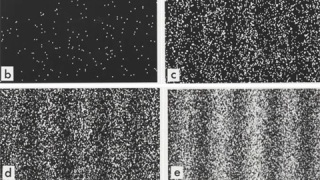Jul 28 2017
One of the main principles of quantum mechanics is the superposition of states. Systems are simultaneously in different states, i.e. "alive and dead" at the same time such as Schrödinger's cat, until someone measures them and the system opts for one of the possibilities. As long as the superposition lasts the system is said to be in a coherent state.
In real systems, a set of diverse elemental particles or atoms existing in a state of superposition, for example, in different positions simultaneously, with different levels of energy, or with two opposite spins (rotating trajectories), are said to have weak coherence: the superposition is broken easily by the vibrations associated with temperature and with the interactions with the environment.
 Researchers at the UAB have come up with a method that allows measuring the strength of the coherence of a quantum state in superposition, similar to Schrödinger's cat. The method is based on the measurement of experimental parameters related to the visibility of interference fringes pattern produced when the two states are superimposed. (Credit: Image excerpted from the article by A. Tonomura et al., Amer. J. Phys. 57(2):117-120, 1989)
Researchers at the UAB have come up with a method that allows measuring the strength of the coherence of a quantum state in superposition, similar to Schrödinger's cat. The method is based on the measurement of experimental parameters related to the visibility of interference fringes pattern produced when the two states are superimposed. (Credit: Image excerpted from the article by A. Tonomura et al., Amer. J. Phys. 57(2):117-120, 1989)
Researchers from the UAB Department of Physics and the Indian Institute of Science, Education and Research Kolkata propose a new way of measuring the robustness of the quantum coherence of a superimposed state. The method is based on the measurement of the visibility of interference fringes, a figure formed by alternate dark and intense stripes similar to that of a zebra, produced when two coherent states coincide.
According to UAB researcher Andreas Winter, “The existence of quantum superpositions is at the heart of the non-classical nature of quantum physics. It manifests itself by producing interference patterns in interferometric experiments. We show that each visibility parameter of the interference pattern , such as the difference between maximums and minimums in intensity, gives rise to a measure of coherence." “The study thus connects the recently burgeoning, but hitherto rather abstract resource theory of coherence, to concrete and physically relevant observations.”
The scientists, experts in information quantum theory, study the intrinsic properties of quantum mechanics such as entanglement, uncertainty, superposition, indeterminism and interference, to be used as resources in a quantum processing of information, the foundation of future quantum computers.
The study was conducted by researchers from the Quantum Information Group at the UAB Department of Physics Andreas Winter (ICREA researcher) and María García Díaz, together with researcher Tanmoy Biswas from the Indian Institute of Science, Education and Research Kolkata.